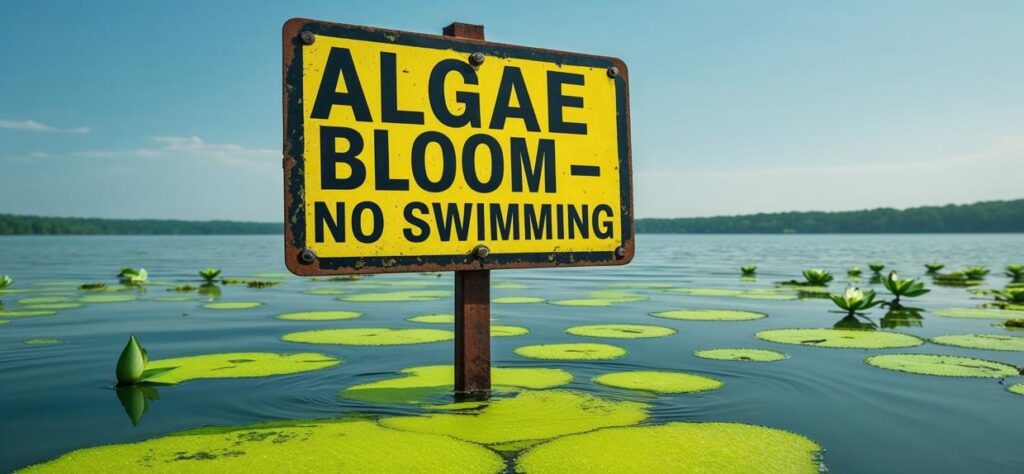
The weather is warming up (at least in the Northern Hemisphere). There is nothing more refreshing on a hot summer day than a dip in cool lake waters, so people everywhere are digging out their swimsuits and hitting the beach. Unfortunately, the same warm temperatures that drive us to the beach can also cause a potentially deadly overgrowth of blue-green algae —also called harmful algal blooms (HABs)—in the water of our favorite pond or lake.
What is Blue-Green Algae and Why is it Dangerous?
The dense growths in water known as blue-green algae is not really algae at all. Instead, they are blooms of the photosynthetic, gram-negative bacteria, cyanobacteria. Cyanobacteria are found in lakes, rivers and ponds all over the globe. Like many bacteria, cyanobacteria can reproduce rapidly under the right conditions—warm, slow-moving water that has plenty of nutrients. The resulting thick mats of growth can resemble aquatic algae growths and often display a blue-green color, earning them the name blue-green algae. However, not all cyanobacterial blooms appear in shades of blue or green. They can be brown, white, red and even purple.
Some cyanobacteria produce toxins called cyanotoxins, which can be neurotoxins, cytotoxins, endotoxins or hepatotoxins. Most cyanotoxins are contained within the cell and are released as the cells begins to die. However, there are some cyanobacteria species that can release their toxins into the water independent of cell death. Once present in the water, these toxins can cause a range of symptoms in people and animals. Minor effects include skin irritation, headaches and mild gastrointestinal upset. In more severe cases, exposure can lead to vomiting, neurological effects, liver damage or even life-threatening outcomes such as respiratory distress, liver failure or cardiac arrest.
How to Keep Blue-Green Algae Blooms from Ruining Your Summer
If you are planning a water outing, check for local water-quality advisories or bloom updates. Many states and municipalities regularly share real-time reports on known HABs as well as testing results online. Agencies like the U.S. Environmental Protection Agency (EPA), the Centers for Disease Control and Prevention (CDC), and individual state Departments of Natural Resources (DNR) closely monitor water conditions and often post advisories when potential dangerous blooms are detected. The information isn’t hard to find; many regions offer online tools or mobile apps that make it easy to access water-quality data on the go. When you get to your destination, always pay attention to any signs posted in the area you plan to swim or boat.
There is no way to visually identify which cyanobacteria species are present in a bloom —or whether they’re producing toxins. Make a habit of doing your own visual assessment of the water and keep pets, livestock and people out of any water where a bloom is visible. Here are some things to look for before you jump in:
- Is the water discolored? Remember cyanobacterial growths aren’t always blue-green.
- Is the water cloudy or murky? If you can’t see very far beneath the surface or the water looks like pea soup, be cautious.
- Are there thick accumulations of scum near the surface or shoreline?
- Do you see blue or green foam, streaks or swirls on the water?
- Is there an unpleasant odor? It might smell like moldy grass or sewage.
Did You Know?
Some local and regional monitoring efforts include citizen science initiatives where volunteers, including students and local residents, can report bloom sightings. These reports help agencies detect potential health threats faster and can contribute to long-term water quality research.
Conclusion
There is nothing more disheartening on a warm summer day than having your plans for relaxing in the water disrupted. But knowing what to look for can help you make safer choices—without missing out on the fun. Cyanobacterial blooms are natural, but they’re not always harmless. A quick scan of the water before you dive in (and a peek at local advisories) might just save your afternoon—and your health. So, pack your sunscreen, double-check the shoreline, and enjoy the summer.
If you are looking for more information about blue-green algae, here are a few links to check out.
- Centers for Disease Control and Prevention. Harmful Algal Bloom and Your Health. https://www.cdc.gov/habs/index.html Accessed July 7, 2025
- U.S. Environmental Protection Agency. Cyanobacterial Harmful Algal Blooms (HABs) in Water Bodies. https://www.epa.gov/habs Accessed July 7, 2025
- Wisconsin Department of Natural Resources. Blue-green Algae. https://dnr.wisconsin.gov/topic/Lakes/BluegreenAlgae Accessed July 7, 2025
Kelly Grooms
Latest posts by Kelly Grooms (see all)
- Unlocking the Power of Live-Cell Kinetics in Degrader Development - September 2, 2025
- Avoid the Summertime Blue-Greens— Know about Cyanobacteria Before You Hit the Water - July 8, 2025
- Growing Our Understanding of Triple-Negative Breast Cancer in Sub-Saharan Africa: Why Comprehensive Population Data Matters - June 5, 2025
